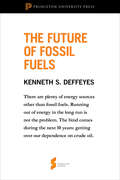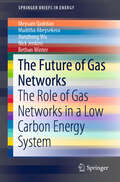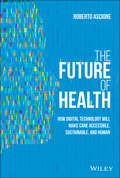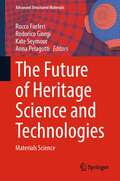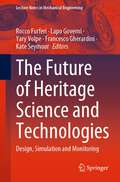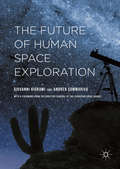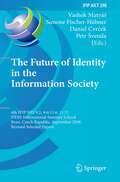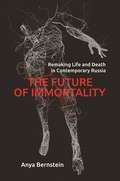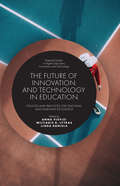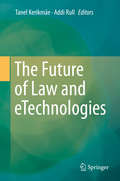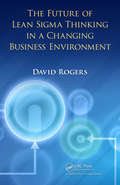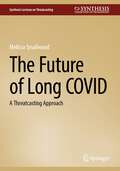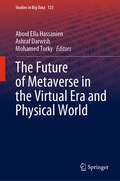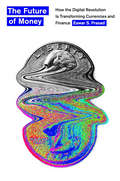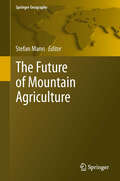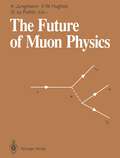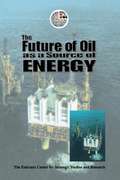- Table View
- List View
The Future of Fossil Fuels: From "Hubbert’s Peak"
by Kenneth S. DeffeyesAs debates about the effects of fossil fuels on our climate and foreign policy intensify, the question of just how much longer we can depend on this finite source of energy becomes more and more pressing. This selection from Hubbert's Peak, the leading book on the limits of our oil supply, forecasts what the future will bring for fossil fuels and what the alternatives are likely to be. Princeton Shorts are brief selections excerpted from influential Princeton University Press publications produced exclusively in eBook format. They are selected with the firm belief that while the original work remains an important and enduring product, sometimes we can all benefit from a quick take on a topic worthy of a longer book. In a world where every second counts, how better to stay up-to speed on current events and digest the kernels of wisdom found in the great works of the past? Princeton Shorts enables you to be an instant expert in a world where information is everywhere but quality is at a premium. The Future of Fossil Fuels does just that.
The Future of Gas Networks: The Role of Gas Networks in a Low Carbon Energy System (SpringerBriefs in Energy)
by Meysam Qadrdan Muditha Abeysekera Jianzhong Wu Nick Jenkins Bethan WinterThis book investigates the role of gas networks in future low-carbon energy systems, and discusses various decarbonisation pathways, providing insights for gas network operators, developers, and policy makers. As more countries around the world move towards low-carbon energy systems and increase their exploitation of renewable energy sources, the use of natural gas and the associated infrastructure is expected to undergo a substantial transformation. As such there is a great uncertainty regarding the future role of gas networks and how they will be operated in coming years.The topics addressed include:Fundamentals of gas network operationThe impact of variable renewable electricity generation on the operation and expansion of gas networksThe impact of decarbonising heat supplies on gas networksOpportunities and challenges of utilising gas networks to transport alternative low-carbon gases such as bio-methane and hydrogen
The Future of Governance: A Radical Introduction to Law
by Roger BrownswordThis book offers a radically different introduction to law, one that reflects the challenges and opportunities presented by the rapid technological developments of our time.Traditionally, law has been about historic principles and rules and their application to a particular set of facts; and courts, judges, and disputes have been central to the legal enterprise. Against this approach, this book highlights four radical and revisionist ideas: by bringing modern technologies into the foreground; by presenting law as one particular mode of governance in a larger picture of governance that now includes technological modalities; by insisting that we have to think outside the traditional doctrinal box to engage with a broad range of governance questions; and by emphasising that human communities cannot flourish without good governance to which both lawyers and law are central. These four radical threads are woven into a discussion of the modern landscape of law, and together they offer a distinctly contemporary contribution to the quest for good governance. The challenge for lawyers now, the book maintains, is to contribute to thinking, both locally and globally, about how we take advantage of the opportunities presented by the newest technology, without compromising the essential conditions for human life and co-existence, and without losing what we value in law’s governance.This book is aimed at students who are studying law at university and legal academics, and others, interested in the current and future impact of technology on law.
The Future of Governance: A Radical Introduction to Law
by Roger BrownswordThis book offers a radically different introduction to law, one that reflects the challenges and opportunities presented by the rapid technological developments of our time.Traditionally, law has been about historic principles and rules and their application to a particular set of facts; and courts, judges, and disputes have been central to the legal enterprise. Against this approach, this book highlights four radical and revisionist ideas: by bringing modern technologies into the foreground; by presenting law as one particular mode of governance in a larger picture of governance that now includes technological modalities; by insisting that we have to think outside the traditional doctrinal box to engage with a broad range of governance questions; and by emphasising that human communities cannot flourish without good governance to which both lawyers and law are central. These four radical threads are woven into a discussion of the modern landscape of law, and together they offer a distinctly contemporary contribution to the quest for good governance. The challenge for lawyers now, the book maintains, is to contribute to thinking, both locally and globally, about how we take advantage of the opportunities presented by the newest technology, without compromising the essential conditions for human life and co-existence, and without losing what we value in law’s governance.This book is aimed at students who are studying law at university and legal academics, and others, interested in the current and future impact of technology on law.
The Future of Health: How Digital Technology Will Make Care Accessible, Sustainable, and Human
by Roberto AscioneLearn how the future of medicine is being unlocked—one digital innovation at a time The Future of Health is an insightful and comprehensive overview of the past, present, and future of digital health. Accomplished health innovation leader Roberto Ascione delivers a practical exploration of how the latest digital technologies are transforming the practice of medicine and redefining health itself by making it more accessible, sustainable, and human. The book includes practical, real-world examples from the United States, Asia, and Europe of technology applications, companies, and start-up that have changed—or will change—our relationship with our health and the healthcare system. Readers will also find: How our health is becoming increasingly consumer and connected while technology is empowering patients in completely new ways and deeply transforming the doctor-patient relationship Discussions of how the training of medical professionals, particularly doctors, has changed—or needs to change—to meet the new digital reality Examinations of how new technologies will allow doctors to dodge many of the administrative and regulatory burdens they currently face each day Treatments of the ability of new technologies to unlock new, holistic ways of practicing medicine, with a focus on latest developments such as Digital Therapeutics and Virtual Reality Reflections on how digital health is fostering a shift “from cure to care” and will unleash a human-sized future for a more accessible, ubiquitous, and sustainable healthcare The Future of Health is required reading for medical practitioners and the managers of pharmaceutical companies. It will also earn a place in the libraries of medical device companies and healthcare entrepreneurs seeking an incisive treatment of the impact of digital technology on all aspects of healthcare. Also, the general public, interested in understanding how to take better control of their own health through digital technologies, will find this book insightful and easy to comprehend.
The Future of Health: How Digital Technology Will Make Care Accessible, Sustainable, and Human
by Roberto AscioneLearn how the future of medicine is being unlocked—one digital innovation at a time The Future of Health is an insightful and comprehensive overview of the past, present, and future of digital health. Accomplished health innovation leader Roberto Ascione delivers a practical exploration of how the latest digital technologies are transforming the practice of medicine and redefining health itself by making it more accessible, sustainable, and human. The book includes practical, real-world examples from the United States, Asia, and Europe of technology applications, companies, and start-up that have changed—or will change—our relationship with our health and the healthcare system. Readers will also find: How our health is becoming increasingly consumer and connected while technology is empowering patients in completely new ways and deeply transforming the doctor-patient relationship Discussions of how the training of medical professionals, particularly doctors, has changed—or needs to change—to meet the new digital reality Examinations of how new technologies will allow doctors to dodge many of the administrative and regulatory burdens they currently face each day Treatments of the ability of new technologies to unlock new, holistic ways of practicing medicine, with a focus on latest developments such as Digital Therapeutics and Virtual Reality Reflections on how digital health is fostering a shift “from cure to care” and will unleash a human-sized future for a more accessible, ubiquitous, and sustainable healthcare The Future of Health is required reading for medical practitioners and the managers of pharmaceutical companies. It will also earn a place in the libraries of medical device companies and healthcare entrepreneurs seeking an incisive treatment of the impact of digital technology on all aspects of healthcare. Also, the general public, interested in understanding how to take better control of their own health through digital technologies, will find this book insightful and easy to comprehend.
The Future of Heritage Science and Technologies: Materials Science (Advanced Structured Materials #179)
by Rocco Furferi Rodorico Giorgi Kate Seymour Anna PelagottiThis book presents selected work from the Florence Heri-Tech, a conference focused on the use of innovative technologies and methods for analyzing, managing, and preserving cultural heritage. This book presents chapters on the chemical and physical advancement in the development of new materials and methods for the conservation and restoration of cultural heritage. It also covers trends in conservation and restoration technology: biotechnology, nanotechnology, tailored materials, and physical technologies. The reader also finds information on methods and instruments for the conservation diagnosis and treatments.
The Future of Heritage Science and Technologies: Design, Simulation and Monitoring (Lecture Notes in Mechanical Engineering)
by Rocco Furferi Lapo Governi Yary Volpe Francesco Gherardini Kate SeymourThis book gathers a selection of contributions dealing with the application of mechanical engineering for preserving and managing cultural heritage. It covers advanced techniques for 3D survey, modeling and simulation, reconstruction, data management as well as advanced diagnostics and testing methods. It highlights strategies to foster sustainability, inclusivity, energy saving and waste reuse in preventive conservation of historical buildings and sculptures, and large heritage sites. Based on contributions presented at the 3rd Florence Heri-Tech International Conference, held on May, 16-18, 2022, in Firenze, Italy, this book offers a timely source of information concerning engineering methods in heritage for both researchers and professionals in the field.
The Future of Human Space Exploration
by Giovanni Bignami Andrea SommarivaFor several decades it has been widely accepted that human space exploration is the exclusive domain of government agencies. The cost of performing such missions, estimated in multiple reports to amount to hundreds of billions dollars over decades, was far beyond what private entities could afford. That arrangement seems to be changing. Buoyed by the success of its program to develop commercial cargo capabilities to support the International Space Station, NASA is becoming increasingly open to working with the private sector in its human space exploration plans. The new private-public partnership will make 'planet hopping' feasible. This book analyses the move towards planet hopping, which sees human outposts moving across the planetary dimensions, from the Moon to Near-Earth Asteroids and Mars. It critically assesses the intention to exploit space resources and how successful these missions will be for humanity. This insightful and accessible book will be of great interest to scholars and students of space policy and politics, international studies, and science and technology studies.
The Future of Identity in the Information Society: 4th IFIP WG 9.2, 9.6, 11.6, 11.7/FIDIS International Summer School, Brno, Czech Republic, September 1-7, 2008, Revised Selected Papers (IFIP Advances in Information and Communication Technology #298)
by Petr Svenda Vashek Matyás Simone Fischer-Hübner Daniel CvrcekWhat constitutes an identity, how do new technologies affect identity, how do we manage identities in a globally networked information society? The increasing div- sity of information and communication technologies and their equally wide range of usage in personal, professional and official capacities raise challenging questions of identity in a variety of contexts. The aim of the IFIP/FIDIS Summer Schools has been to encourage young a- demic and industry entrants to share their own ideas about privacy and identity m- agement and to build up collegial relationships with others. As such, the Summer Schools have been introducing participants to the social implications of information technology through the process of informed discussion. The 4th International Summer School took place in Brno, Czech Republic, during September 1–7, 2008. It was organized by IFIP (International Federation for Infor- tion Processing) working groups 9.2 (Social Accountability), 9.6/11.7 (IT Misuse and the Law) and 11.6 (Identity Management) in cooperation with the EU FP6 Network of Excellence FIDIS and Masaryk University in Brno. The focus of the event was on security and privacy issues in the Internet environment, and aspects of identity m- agement in relation to current and future technologies in a variety of contexts.
The Future of Immortality: Remaking Life and Death in Contemporary Russia (Princeton Studies in Culture and Technology #23)
by Anya BernsteinA gripping account of the Russian visionaries who are pursuing human immortalityAs long as we have known death, we have dreamed of life without end. In The Future of Immortality, Anya Bernstein explores the contemporary Russian communities of visionaries and utopians who are pressing at the very limits of the human.The Future of Immortality profiles a diverse cast of characters, from the owners of a small cryonics outfit to scientists inaugurating the field of biogerontology, from grassroots neurotech enthusiasts to believers in the Cosmist ideas of the Russian Orthodox thinker Nikolai Fedorov. Bernstein puts their debates and polemics in the context of a long history of immortalist thought in Russia, with global implications that reach to Silicon Valley and beyond. If aging is a curable disease, do we have a moral obligation to end the suffering it causes? Could immortality be the foundation of a truly liberated utopian society extending beyond the confines of the earth—something that Russians, historically, have pondered more than most? If life without end requires radical genetic modification or separating consciousness from our biological selves, how does that affect what it means to be human?As vividly written as any novel, The Future of Immortality is a fascinating account of techno-scientific and religious futurism—and the ways in which it hopes to transform our very being.
The Future of Immortality: Remaking Life and Death in Contemporary Russia (Princeton Studies in Culture and Technology #23)
by Anya BernsteinA gripping account of the Russian visionaries who are pursuing human immortalityAs long as we have known death, we have dreamed of life without end. In The Future of Immortality, Anya Bernstein explores the contemporary Russian communities of visionaries and utopians who are pressing at the very limits of the human.The Future of Immortality profiles a diverse cast of characters, from the owners of a small cryonics outfit to scientists inaugurating the field of biogerontology, from grassroots neurotech enthusiasts to believers in the Cosmist ideas of the Russian Orthodox thinker Nikolai Fedorov. Bernstein puts their debates and polemics in the context of a long history of immortalist thought in Russia, with global implications that reach to Silicon Valley and beyond. If aging is a curable disease, do we have a moral obligation to end the suffering it causes? Could immortality be the foundation of a truly liberated utopian society extending beyond the confines of the earth—something that Russians, historically, have pondered more than most? If life without end requires radical genetic modification or separating consciousness from our biological selves, how does that affect what it means to be human?As vividly written as any novel, The Future of Immortality is a fascinating account of techno-scientific and religious futurism—and the ways in which it hopes to transform our very being.
The Future of Innovation and Technology in Education: Policies and Practices for Teaching and Learning Excellence (Emerald Studies in Higher Education, Innovation and Technology)
by Anna Visvizi Miltiadis D. Lytras Linda DanielaThis book focuses on approaches to teaching and learning that integrate emerging technologies to enhance the quality of education. It brings together conceptual and empirical insights to elaborate on the design of effective programs, educational policies and educational administration requirements. The chapters cover topics such as social media’s use in learning, virtual learning, innovative pedagogy, data mining, massive open online courses (MOOCs) and sustainable education. Special emphasis is placed on virtual and augmented reality (VR/AR), and the use of electronic devices such as tablets and smartphones in the classroom. The authors explore how advances in information and communication technology (ICT) can improve opportunities through education for all. It presents an international perspective, with authors from Europe, Asia, the Middle East, and North and South America.
The Future of Innovation and Technology in Education: Policies and Practices for Teaching and Learning Excellence (Emerald Studies in Higher Education, Innovation and Technology)
by Anna Visvizi Miltiadis D. Lytras Linda DanielaThis book focuses on approaches to teaching and learning that integrate emerging technologies to enhance the quality of education. It brings together conceptual and empirical insights to elaborate on the design of effective programs, educational policies and educational administration requirements. The chapters cover topics such as social media’s use in learning, virtual learning, innovative pedagogy, data mining, massive open online courses (MOOCs) and sustainable education. Special emphasis is placed on virtual and augmented reality (VR/AR), and the use of electronic devices such as tablets and smartphones in the classroom. The authors explore how advances in information and communication technology (ICT) can improve opportunities through education for all. It presents an international perspective, with authors from Europe, Asia, the Middle East, and North and South America.
The Future of Law and eTechnologies
by Tanel Kerikmäe Addi RullThis book presents groundbreaking discussions on e-residency, cryptocurrencies, scams, smart contracts, 3D printing, software agents, digital evidence and e-governance at the intersection of law, legal policies and modern technologies. The reader benefits from cutting-edge analyses that offer ideas and solutions to some of the most pressing issues caused by e-technologies. This collection is a useful tool for law and IT practitioners and an inspiring source for interdisciplinary research. Besides serving as a practical guideline, this book also reflects theoretical dimensions of future perspectives, as new technologies are not meant to change common values but to accommodate them.
The Future of Lean Sigma Thinking in a Changing Business Environment
by David RogersOf the 100 companies named to Fortune magazine’s list of the world’s largest companies in 1956, only 29 of those companies remain on that list. Many lost their way because they failed to recognize the changes taking place, or were too big to react quickly enough to shifting market conditions. Supplying Lean practitioners with a formal process for keeping up with technological advancements and shifting business requirements, The Future of Lean Sigma Thinking in a Changing Business Environment provides the tools to survive and prosper through the current business environment. It introduces cutting-edge business solutions from the fields of chemical engineering, aircraft production, and business psychology, and explains how to integrate these concepts with proven Lean principles. The book begins by providing a foundation in essential Lean concepts, including Deming and Juran, Six Sigma, Total Quality Management, the Toyota Production System, and New Six Sigma. Next, it reports on the latest advances in process understanding. By analyzing changing attitudes within the system, it illustrates how new products are being developed using updated Lean thinking. In addition, it provides examples that demonstrate the impact of e-commerce on Lean production systems. Incorporating the green agenda to Lean thinking, the text supplies the insight to safely navigate your company through a shifting business landscape while reducing your impact on raw materials and the environment. By following the principles discussed in this book, you will not only increase your company’s chances of achieving long-term survival but will position your organization to capitalize on the economic upturn on the horizon.
The Future of Lean Sigma Thinking in a Changing Business Environment
by David RogersOf the 100 companies named to Fortune magazine’s list of the world’s largest companies in 1956, only 29 of those companies remain on that list. Many lost their way because they failed to recognize the changes taking place, or were too big to react quickly enough to shifting market conditions. Supplying Lean practitioners with a formal process for keeping up with technological advancements and shifting business requirements, The Future of Lean Sigma Thinking in a Changing Business Environment provides the tools to survive and prosper through the current business environment. It introduces cutting-edge business solutions from the fields of chemical engineering, aircraft production, and business psychology, and explains how to integrate these concepts with proven Lean principles. The book begins by providing a foundation in essential Lean concepts, including Deming and Juran, Six Sigma, Total Quality Management, the Toyota Production System, and New Six Sigma. Next, it reports on the latest advances in process understanding. By analyzing changing attitudes within the system, it illustrates how new products are being developed using updated Lean thinking. In addition, it provides examples that demonstrate the impact of e-commerce on Lean production systems. Incorporating the green agenda to Lean thinking, the text supplies the insight to safely navigate your company through a shifting business landscape while reducing your impact on raw materials and the environment. By following the principles discussed in this book, you will not only increase your company’s chances of achieving long-term survival but will position your organization to capitalize on the economic upturn on the horizon.
The Future of Long COVID: A Threatcasting Approach (Synthesis Lectures on Threatcasting)
by Melissa SmallwoodThis book provides an overview of Long COVID, the chronic illness and disability that can result from COVID-19 infection in 20–30% of survivors. It approaches the topic through its larger social, political, and historical context utilizing the Threatcasting methodology for scenario-based foresight. The book brings together multiple perspectives on Long COVID, such as patient experiences, healthcare system impacts, historical frameworks, and the information ecosystem surrounding COVID to explore the long-term structural implications of Long COVID beyond the current acute crisis. It is intended to be a guide for policy makers, healthcare providers, researchers, and anyone whose work will play a role in mitigating the long tail of COVID-19. Framing the pandemic within a historical and political framework while approaching Long COVID from the future-casting perspective, this book seeks to disentangle the issues posed by Long COVID from the current moment and is intended to establish new ways of thinking about and preparing for similar complex, over-the-horizon potential threats. The first book to apply the Threatcasting framework to a public-health issue like COVID-19Draws together multiple perspectives of Long COVID that were previously discussed independently within their fieldsComprehensively examines the history and future of Long COVID
The Future of Manufacturing: The Italian Roadmap (Springer Tracts in Mechanical Engineering)
by Rosanna Fornasiero Tullio A. M. TolioThis book is an open access publication. This book explores innovation paths for improving the positioning of the manufacturing sector in the international arena. The roadmap is the result of intense work over two years, during which companies, universities, research bodies, and associations came together to build a systemic vision for the themes of research and technological innovation with a medium to long term outlook. The work is based on a collaborative framework whereby top-down analysis of the global development trends and scenarios generating the challenges for manufacturing is integrated with a bottom-up approach that engages the Cluster's members in bringing forward their research needs. The roadmap's proposal is structured along 7 strategic action lines designed to face the challenges from the market such as personalized production, industrial sustainability, valorization of humans in factories, high efficiency, and to seize and develop the opportunities offered by enabling technologies such as innovative production processes, evolving and reconfigurable processes, cybersecurity, AI, and digital platforms.
The Future of Metaverse in the Virtual Era and Physical World (Studies in Big Data #123)
by Aboul Ella Hassanien Ashraf Darwish Mohamed TorkyThis book is divided into three parts. The first part discusses the Metaverse's basics, development, and optional applications such as 3D virtual dressing room-based user-friendly Metaverse, the use of Metaverse in the healthcare and environment sectors as well as the ethics of the Metaverse and digital virtual environments. Part two presents some chapters that discuss emerging technologies in the Metaverse world including IoT, digital twining, and artificial intelligence and shows its impact on climate change. The third part contains chapters discussing cybersecurity in the Metaverse including blockchain technology opportunities and applications and the threat of the digital humanities in the Metaverse. The book is suitable for students and academics aiming to build up their background on the Future of the Metaverse in the Virtual Era and Physical World.
The Future of Money: How the Digital Revolution Is Transforming Currencies and Finance
by Eswar S. PrasadA cutting-edge look at how accelerating financial change, from the end of cash to the rise of cryptocurrencies, will transform economies for better and worse. We think we’ve seen financial innovation. We bank from laptops and buy coffee with the wave of a phone. But these are minor miracles compared with the dizzying experiments now underway around the globe, as businesses and governments alike embrace the possibilities of new financial technologies. As Eswar Prasad explains, the world of finance is at the threshold of major disruption that will affect corporations, bankers, states, and indeed all of us. The transformation of money will fundamentally rewrite how ordinary people live. Above all, Prasad foresees the end of physical cash. The driving force won’t be phones or credit cards but rather central banks, spurred by the emergence of cryptocurrencies to develop their own, more stable digital currencies. Meanwhile, cryptocurrencies themselves will evolve unpredictably as global corporations like Facebook and Amazon join the game. The changes will be accompanied by snowballing innovations that are reshaping finance and have already begun to revolutionize how we invest, trade, insure, and manage risk. Prasad shows how these and other changes will redefine the very concept of money, unbundling its traditional functions as a unit of account, medium of exchange, and store of value. The promise lies in greater efficiency and flexibility, increased sensitivity to the needs of diverse consumers, and improved market access for the unbanked. The risk is instability, lack of accountability, and erosion of privacy. A lucid, visionary work, The Future of Money shows how to maximize the best and guard against the worst of what is to come.
The Future of Mountain Agriculture (Springer Geography)
by Stefan MannMountain agriculture is a socially and culturally unique system, but also a regionally important economic sector. In a globalising world, it is clear that fertile areas on all continents will always be used to produce large quantities of agricultural products in order to feed the world and, increasingly, provide biomass as a source of energy. It is far less clear, however, how land use in steep and more peripheral regions will evolve. By definition, farmland in mountain areas is more difficult to work because of steep slopes and missing accessibility. Climate conditions and poor soil quality often add to these adverse conditions. Through overcoming limited views from one region only or from one discipline, this book intends to draw a first truly international perspective on the issue of mountain farming.
The Future of Muon Physics: Proceedings of the International Symposium on The Future of Muon Physics, Ruprecht-Karls-Universität Heidelberg, Heidelberg, Federal Republic of Germany, 7–9 May, 1991
by Klaus Jungmann Vernon W. Hughes Gisbert Zu PutlitzThis volume comprises a collection of invited papers presented at the interna tional symposium "The Future of Muon Physics", May 7-9 1991, at the Ruprecht Karls-Universitat in Heidelberg. In the inspiring atmosphere of the Internationales Wissenschaftsforum researchers working worldwide at universities and at many inter national accelerator centers came together to review the present status of the field and to discuss the future directions in muon physics. The muon, charged lepton of the second generation, was first oberved some sixty years ago~ Despite many efforts since, the reason for its existence still remains a secret to the scientific community challenging both theorists and experimentalists. In modern physics the muon plays a key role in many topics of research. Atomic physics with negative muons provides excellent tests of the theory of quantum electrodynamics and of the electro-weak interaction and probes nuclear properties. The. purely leptonic hydrogen-like muonium atom allows tests of fun damental laws in physics and the determination of precise values for fundamental constants. New measurements of the anomalous magnetic moment of the muon will probe the renormalizability of the weak interaction and will be sensitive to physics beyond the standard model. The muon decay is the most carefully studied weak process. Searches for rare decay modes of muons and for the conversion of muonium to antimuonium examine the lepton number conservation laws and new speculative theories. Nuclear muon capture addresses fundamental questions like tests of the CPT theorem.
The Future of Oil as a Source of Energy
by The Emirates Center for Strategic Studies and ResearchWhat is the future of oil as a primary source of energy? Is the world moving inexorably towards the end of the oil era? This book provides a comprehensive analysis of the future of oil by assessing the present realities and prospects of the oil sector, tracing the growth of alternative and renewable energy sources and examining the impact of environmental concerns. The volume also focuses on aspects of energy quality in the ongoing energy transition, highlights new technological developments in the oil industry and suggests ways to ensure price stability in the oil market.
The Future of Oil as a Source of Energy
by The Emirates Center for Strategic Studies and ResearchWhat is the future of oil as a primary source of energy? Is the world moving inexorably towards the end of the oil era? This book provides a comprehensive analysis of the future of oil by assessing the present realities and prospects of the oil sector, tracing the growth of alternative and renewable energy sources and examining the impact of environmental concerns. The volume also focuses on aspects of energy quality in the ongoing energy transition, highlights new technological developments in the oil industry and suggests ways to ensure price stability in the oil market.
